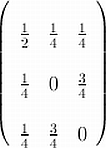Board problem: Write the doubly stochastic matrix

Bonus question: Prove that no permutation matrix is the convex combination of other permutation matrices.
Our second test is on Wednesday October 30. You may download the Sample Test 2 to prepare for it.
Bonus question: 4.1/8
For 3.4/c you should use Mike Copley's Java applet to build a heap (note: it does not take negative numbers, so you have to "cheat"). Then apply the algorithm described in the book and shown in Figure 3.25 to sort the heap. Warning: the procedure in our book to sort the heap is different from what is shown by the applet, so only use the applet to build the heap. Show each stage of the heap while it is being sorted.
Board problem: Use bubble sort to sort the list 5,1,3,4,2. Show all phases.
Bonus problems:
- Show that, allowing disconnected countries, no fixed number of colors suffices to color all maps.
- Prove Grinberg's theorem (Section 2.2, Theorem 3).
- Find and prove a formula for the chromatic polynomial of a circuit Cn of length n.
Bonus problem (2pts), expires when this assignment is due: Find the theorem in the book (page number, theorem number) stating the number of edges of a tree.
Bonus questions:
- 1.2/6e
- Prove that the edge graph of the n-dimensional hypercube is bipartite. (The vertices of the n-dimensional hypercube are all 01-strings of length n, two vertices are adjacent when exactly one of their coordinates differs.)